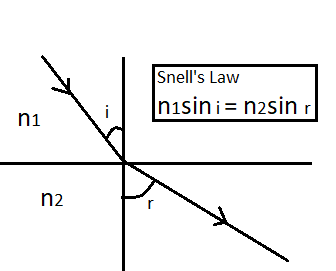
Which law describes; ${n_1}\sin i = {n_2}\sin r$ $\to$ _ _ _ _ _ _ _ (Newton’s, Snell’s ) Law.
Answer
576k+ views
Hint: Light shows different phenomena when it travels such as reflection, refraction, polarisation, diffraction etc. We can solve this problem with the help of refraction phenomena of light. In optical physics, refraction is the change in the direction of light waves when it travels from one medium to another medium. The other waves in nature also follow the refraction phenomena as sound waves and water waves.
Complete answer:
Refraction can be seen in our everyday life, for example rainbow and mirages are natural optical phenomena. Refraction follows the Snell’s law. When a light rays travels from one medium to another, it deflects from its original position. The Snell’s law states that the ratio of the sines of the angle of incidence ${\theta _1}$ to the angel of refraction ${\theta _2}$ is equal to the constant ($\mu $) which is the refractive index of the medium 2 relative to the medium1. This is expressed as:
$\dfrac{{\sin i}}{{\sin r}} = \mu = \dfrac{{{n_2}}}{{{n_1}}}$ where ${n_1}$ is the refractive index of medium 1, ${n_2}$ is the refractive index of medium 2, $i$ is the angle of incidence and $r$ is the angle of refraction.
The diagrammatic representation is as follows:

So for the given question , Snell’s law is the suitable word for space given.
Note:
This law has a wide range of applications in the optical branch of physics. When the refraction occurs at the intersecting point, the speed of light and the wavelength of the light wave is changed but the frequency will remain the same in both the medium. Refraction is responsible for many natural phenomena such as mirages, rainbow.
Complete answer:
Refraction can be seen in our everyday life, for example rainbow and mirages are natural optical phenomena. Refraction follows the Snell’s law. When a light rays travels from one medium to another, it deflects from its original position. The Snell’s law states that the ratio of the sines of the angle of incidence ${\theta _1}$ to the angel of refraction ${\theta _2}$ is equal to the constant ($\mu $) which is the refractive index of the medium 2 relative to the medium1. This is expressed as:
$\dfrac{{\sin i}}{{\sin r}} = \mu = \dfrac{{{n_2}}}{{{n_1}}}$ where ${n_1}$ is the refractive index of medium 1, ${n_2}$ is the refractive index of medium 2, $i$ is the angle of incidence and $r$ is the angle of refraction.
The diagrammatic representation is as follows:

So for the given question , Snell’s law is the suitable word for space given.
Note:
This law has a wide range of applications in the optical branch of physics. When the refraction occurs at the intersecting point, the speed of light and the wavelength of the light wave is changed but the frequency will remain the same in both the medium. Refraction is responsible for many natural phenomena such as mirages, rainbow.
Recently Updated Pages
A man running at a speed 5 ms is viewed in the side class 12 physics CBSE

The number of solutions in x in 02pi for which sqrt class 12 maths CBSE

State and explain Hardy Weinbergs Principle class 12 biology CBSE

Write any two methods of preparation of phenol Give class 12 chemistry CBSE

Which of the following statements is wrong a Amnion class 12 biology CBSE

Differentiate between action potential and resting class 12 biology CBSE

Trending doubts
What are the major means of transport Explain each class 12 social science CBSE

Differentiate between homogeneous and heterogeneous class 12 chemistry CBSE

What is virtual and erect image ?

What is the Full Form of PVC, PET, HDPE, LDPE, PP and PS ?

The first microscope was invented by A Leeuwenhoek class 12 biology CBSE

Write any three uses of polaroids class 12 physics CBSE




